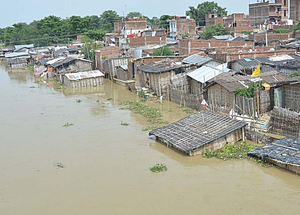Bihar staring at ‘hydro-meteorological disasters’; 14 districts most at risk
People in Bihar are experiencing early chilly weather this winter season and the met department is expecting 1 to 3 degrees minimum temperature in the next 24 hours. This may be a temporary phase but it is a reflection of the change in the climate due to various reasons, says an expert.
He said there are various reasons for the climate change here during summer and winter. The state is lacking green cover especially in the rural areas. Bihar, over the years, is facing disasters like the annual floods in North Bihar and a drought-like situation in South Bihar every year.
As per a study by the Journal of Natural Science Research, 21% of the total area comes under seismic zone 5. Bihar has 14 districts which are highly vulnerable due to lack of forest cover, flood affected zones and other issues. Around 70% of the districts have a wind speed of nearly 50 meters/second which is considered very high. The northern part of Bihar has low lying plains where water from Nepal accumulates. Rivers like the Kosi, Kamla Balan, Gandak, Parman originate from the Himalayas and their water crosses various North Bihar districts to finally fall into the Ganga river.
The biggest challenge for the state government is the silt carried by these rivers and its accumulation in the low lying areas of North Bihar, affecting the natural drainage. This became worse after the drainage system in various districts was developed in an unplanned manner. The water comes from the Himalayan range but does not exit to other sides due to the poor drainage system.
Around 21 districts including West Champaran, East Champaran, Sheohar, Supaul, Darbhanga, Samastipur, Khagaria, Katihar, Kishanganj, Araria, Purnea, Madhubani, Samastipur, Muzaffarpur, Gopalganj, Siwan, Saran, Vaishali, Patna and many others are hit by floods every monsoon season. “The actual reason for flood water accumulating in these districts is the siltation and the poor drainage system. The state government has failed to construct a drainage system in a well planned manner. In the last few years, various people in the government and different agencies are discussing it and expressing concern about the changes in the weather but because of political apathy, Bihar does not have an action plan on the ground,” said Bharat Sharma, a Patna based environmentalist.
Dinesh Kumar Mishra, research expert (IIT Kharagpur) on the Bihar flood situation, pointed out that the poor functioning of the state government is responsible for the problem. “Everyone in the government and engineers in the water resource department know that siltation and drainage are the key issues to resolve the problem but the government looks only at temporary solutions. When the Kushaha tragedy happened in the Kosi region in 2008, the Nitish Kumar government had given compensation to the affected families and they kept quiet. No one spoke about permanent solutions. The state government opens a control room in Patna to monitor the flood situation every year from May 15 to October 15. Every year, floods occur in July. Why can the control room not work for 12 months? They know the problem but have failed to address it,” Mishra told IANS.
“In 1955, the farmers of North Bihar said that flood waters remained for two and a half days in their villages. Now, the water stays for 4 to 6 months in some of the districts like Supaul and Sheohar. Why did it happen? The natural drainage systems were disturbed at a massive level. Hence the water does not drain towards the nearby rivers,” he said.
The Bihar government has formulated a plan to connect the rivers with one another. Recently, the Nitish Kumar government had brought Ganga water to districts like Nalanda, Gaya and Nawada. The experts believe that such efforts are needed in North Bihar as well to connect various rivers and drainage systems with rivers through channels to address these issues.
The Nitish Kumar government launched the Jan Jeevan Hariyali programme on October 2, 2019 and allocated Rs 24,524 crore to promote ecological balance and water conservation in the state. One of its goals was to deal with water scarcity especially in the southern part of Bihar. This needs proper implementation in districts like Gaya, Nawada, Aurangabad, Jamui Sheikhpura and others.
The government came with the Bihar State Action Plan of Climate Change in 2015 and made sectoral plans to deal with it. However, the implementation was lacking. In the same year, the state government constituted a team of experts to make an action plan with the help of the Department For International Development (DFID). the DFID suggested some measures like desiltation in North Bihar especially in the Kosi range, strengthening agricultural chains, development of agro based industries. The government, through the Bihar state pollution control board signed a memorandum of understanding with the United Nations Environment Programme India in February 2021 to prepare strategies to build climate resilience and reach net zero emission by 2070.

